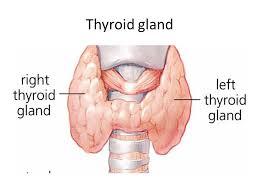What is an Enlarged Thyroid?
Enlarged Thyroid is a n enlargement of the thyroid gland is medically known as goiter. Usually, the thyroid enlarges and expands beyond its normal size causing a noticeable bulge in your neck.



Fig 1: Showing a bulging or an enlarged thyroid
Location and Shape
This is a small gland found under the skin of your neck and below Adam’s Apple measuring approximately 5 centimeters in width. Its shape resembles a butterfly or bow tie as the two halves of the gland connect in the middle or isthmus.
You can only barely feel the thyroid in normal circumstances, but if it becomes enlarged, doctors can easily feel it and a noticeable bulge may appear below or at the sides of your Adam’s Apple.

Functions of Thyroid
It functions as an endocrine gland secreting thyroid hormones, which control metabolic activities in your body. These activities are involved in vital body functions such as controlling your heart rate, fertility, and digestion.
Disorders of the thyroid range from mild goiter that requires no treatment in most cases to the more severe thyroid cancer. In older people, thyroid disorders that manifest in the form of hyperthyroidism and hypothyroidism are common and usually mistaken for signs of getting old or other conditions.
People over the 70-year mark are advised to have their blood levels of the thyroid stimulating hormone measured.[1,8]
Causes of Goiter
Goiter is the noncancerous enlargement of the thyroid gland. The levels of the thyroid hormones may be unaffected as with nontoxic goiter, elevated as in the case of hyperthyroidism or decreased as in hypothyroidism.
If you consume large amounts of food that interfere with the thyroid’s ability to process iodine, you may have sporadic goiter problems. Some of the foods that interfere with such thyroid functions include:
- Cabbage
- Spinach
- Soybeans
- Peaches.
Conditions that cause hyperthyroidism or hypothyroidism, also lead to goiter. For example, Grave’s disease and Hashimoto’s disease are known to interfere with the normal, regular production of thyroid hormones.
Development of nodules in the thyroid gland cause goiter referred to as nontoxic goiter. Nontoxic goiter is enlargement of the thyroid gland that is not associated with the abnormal function of the thyroid. That is, it does not result from either an inflammatory or neoplastic process.
Thyroid cancer is a condition that can manifest in the enlargement of one side of the thyroid gland. In order to understand the enlargement of the goiter, it is prudent to understand what the thyroid gland is and functions relating to it. 3, 5, 7
Causes of Nontoxic Goiter
Nontoxic goiter may arise due to:
Deficiency of iodine
This is rare case because of the ready availability of iodine in our diets although other factors may affect how the body processed iodine.
Increased thyroid stimulating hormone
This is a more common cause of goiter as a response to a defect in its synthesis within the thyroid gland. The hormone is produced in the pituitary and the resulting manifests after many years in most cases.
Causes of Hyperthyroidism
Hyperthyroidism relates to the overproduction of thyroid hormones and can occur as a result of the following:
Graves’ disease
This triggers overstimulation of the thyroid gland leading to the overproduction of thyroid hormone that makes it swell.

Multinodular goiter
This occurs when multiple lumps form in the thyroid making it larger than normal. These nodules also secrete thyroid hormones and upset the chemical balance in the body.
Inflammation of the thyroid
This results in temporary hyperthyroidism as a result of the ‘leaking’ hormones from the thyroid gland. It is referred to as subacute thyroiditis and is observed to last for a few weeks, although it may persist for months.
Malfunctioning of pituitary gland or cancers
In rare cases, this can trigger symptoms of hyperthyroidism. Thyroid cancer, for example, causes the enlargement of one side of the thyroid gland.
Hashimoto’s thyroiditis
Also called Hashimoto’s disease, this is an autoimmune disorder where the body attacks the thyroid tissue. When this happens, there is low production of thyroid hormones. In the end, the tissue dies and stops producing the hormones, altogether.

Where thyroid gland removed
The thyroid gland is removed surgically or sometimes, it is destroyed, chemically.
Exposure to large amounts of iodide
When you have thyroid problems, it is risky to be exposed to too much iodine, for example, that given in contrast dyes before taking an X-ray.
Lithium
This has also been implicated in causing hypothyroidism.
Myxedema coma
This is a rare condition caused by prolonged untreated hypothyroidism and is fatal. 3, 8
Symptoms of an Enlarged Thyroid
A goiter may be small, moderate or at times, it may be so large compressing the trachea and esophagus. Typically, a goiter is painless, but if it grows large, it causes other uncomfortable and unpleasant symptoms. Symptoms resulting from the goiter primarily include:
- Problems associated with swallowing and experiencing a sensation like food is getting stuck in your upper throat after; when eating.
- Shortness of breath including waking up feeling like you cannot breathe.
- Hoarseness and stridor. Stridor is a wheezing sound that results from the turbulent air flow in and out of the obstructed trachea.
When hyperthyroidism or hypothyroidism is the reason behind your enlarged thyroid, other symptoms associated with thyroid disorders such as fatigue or sweating a lot can accompany those discussed above.
Diagnosis
The diagnosis involves a physical examination as well as taking blood tests to confirm some primary underlying conditions.
Physical exam
Feeling for nodules or observing the enlargement is one of the physical tests your doctor can use to detect the enlargement.
Testing the levels
For either hyperthyroidism or hypothyroidism, doctors consider hormones secreted by the thyroid and the thyroid stimulating hormone (TSH). TSH is produced by the pituitary gland to influence the production of hormones in the thyroid.
Confirmatory test
The amount of TSH circulating in your blood is high whereas levels of thyroid hormones are low. To identify the cause, the doctor often uses radioactive iodide uptake tests to track the amount of iodine absorbed by your thyroid gland.
Confirmatory test f
The levels of TSH are below normal and those of the thyroid hormones high.
Evaluating the nodules (ultrasound)
Nodules on the thyroid that cause it to enlarge are cysts filled with fluid and normally benign.
X-ray
This may be used in patients who complain of a cough or change in their voice, or at times they have night time episodes of choking. The X-ray shows how the enlarged thyroid has pushed the patient’s trachea to the right when it should be straight from the mouth down to the lungs.
Treatment
Small unnoticeable goiters that do not cause other significant symptoms do not require treatment in most cases. Some of the treatment options available include:
- Aspirin and corticosteroid medication to help ease inflammation of the thyroid gland.
- Medications to stabilize the hormone levels may be administered to patients confirmed by diagnostic tests as suffering from hyperthyroidism.
- Orally administered radioactive iodine can also be used to cure an overactive gland by destroying the thyroid cells.
- Thyroid hormone replacement can relieve the symptoms of hypothyroidism and reduce the size of the goiter by affecting the release of thyroid-stimulating hormone from the gland.
- Administering doses of the thyroid hormone in the form of a pill is one of the hormone therapies used. And, although it may not reduce the goiter’s size, it keeps it from growing any larger. Patients who do not respond to such therapy require surgery.
- Doctors may recommend thyroidectomy to take away some portions of the thyroid gland or completely remove it. Cases that require total removal include situations where structures like the trachea and esophagus are compressed or the enlarged thyroid is suspected to be malignant in a multinodular goiter.
- However, removal of goiter fearing the risk of cancer is not warranted for most patients.
Reference List
- The thyroid gland. https://www.merckmanuals.com/home/hormonal-and-metabolic-disorders/thyroid-gland-disorders/overview-of-the-thyroid-gland
- Enlarged thyroid. http://www.medicinenet.com/script/main/art.asp?articlekey=3615
- Enlarged thyroid. https://www.reference.com/health/enlarged-thyroid-c1ebbc06933a2fc6?qo=cdpArticles
- Goiter. http://emedicine.medscape.com/article/120392-overview
- Multinodular goiter. http://www.btf-thyroid.org/information/leaflets/32-thyroid-nodules-and-swellings-guide
- Enlarged thyroid. http://www.mayoclinic.org/enlarged-thyroid/IMG-20005923
- Goiter. https://www.endocrineweb.com/conditions/thyroid/thyroid-goiter
- Thyroid disorders. http://www.webmd.com/women/guide/understanding-thyroid-problems-basics#1
- Treatment of thyroid disorders. http://www.webmd.com/women/understanding-thyroid-problems-treatment#1
- Symptoms and treatment of goiter. http://www.medicinenet.com/goiter_causes_symptoms_and_treatment/views.htm
